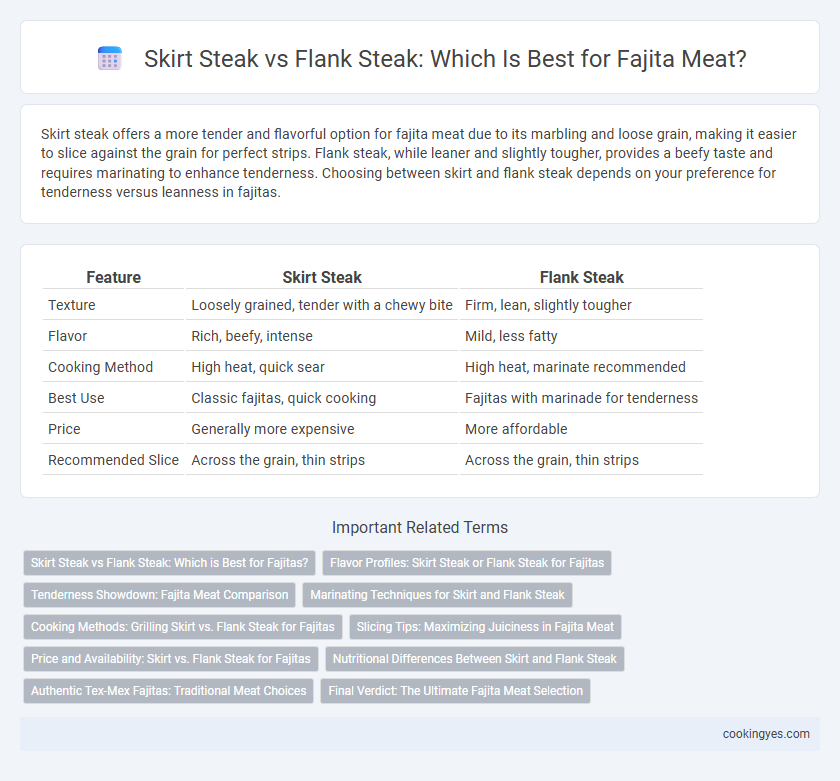Skirt steak offers a more tender and flavorful option for fajita meat due to its marbling and loose grain, making it easier to slice against the grain for perfect strips. Flank steak, while leaner and slightly tougher, provides a beefy taste and requires marinating to enhance tenderness. Choosing between skirt and flank steak depends on your preference for tenderness versus leanness in fajitas.
Table of Comparison
| Feature | Skirt Steak | Flank Steak |
|---|---|---|
| Texture | Loosely grained, tender with a chewy bite | Firm, lean, slightly tougher |
| Flavor | Rich, beefy, intense | Mild, less fatty |
| Cooking Method | High heat, quick sear | High heat, marinate recommended |
| Best Use | Classic fajitas, quick cooking | Fajitas with marinade for tenderness |
| Price | Generally more expensive | More affordable |
| Recommended Slice | Across the grain, thin strips | Across the grain, thin strips |
Skirt Steak vs Flank Steak: Which is Best for Fajitas?
Skirt steak is favored for fajitas due to its rich marbling and intense beefy flavor, which makes it tender and juicy when cooked quickly over high heat. Flank steak, while leaner and less fatty, offers a firmer texture and a slightly milder taste but requires careful slicing against the grain to maximize tenderness. For authentic fajitas, skirt steak generally delivers superior flavor and tenderness, making it the preferred choice among chefs and home cooks alike.
Flavor Profiles: Skirt Steak or Flank Steak for Fajitas
Skirt steak offers a rich, beefy flavor with a pronounced grain that absorbs marinades well, making it ideal for fajitas requiring robust taste. Flank steak, while leaner, provides a slightly milder flavor and a firmer texture, delivering a cleaner bite with subtle beefiness. Choosing skirt steak enhances the traditional fajita experience with intense flavor, whereas flank steak suits preferences for a leaner, tender option without sacrificing depth.
Tenderness Showdown: Fajita Meat Comparison
Skirt steak offers a more tender and flavorful option for fajitas due to its loose grain and higher fat content, enhancing juiciness and mouthfeel. Flank steak, while leaner, requires proper marinating and slicing against the grain to achieve comparable tenderness. Choosing skirt steak generally ensures a superior texture and more succulent bite, making it the preferred cut for authentic fajita meat.
Marinating Techniques for Skirt and Flank Steak
Marinating skirt steak for fajitas involves using acidic ingredients like lime juice and vinegar to tenderize its loose grain and enhance its bold beefy flavor. Flank steak benefits from longer marinating times with a mixture of soy sauce, garlic, and olive oil to break down its denser muscle fibers, resulting in a juicier and more flavorful cut. Both cuts should be marinated for at least 2 to 6 hours to maximize tenderness and infuse vibrant fajita spices throughout the meat.
Cooking Methods: Grilling Skirt vs. Flank Steak for Fajitas
Skirt steak and flank steak are both popular choices for fajitas, but their cooking methods differ due to texture and thickness. Skirt steak, with its loose grain and thin cut, benefits from high-heat, quick grilling to achieve a charred exterior and tender interior without overcooking. Flank steak, being leaner and thicker, requires a slightly longer grilling time at medium-high heat, often combined with marinating and slicing against the grain to maximize tenderness for perfect fajita meat.
Slicing Tips: Maximizing Juiciness in Fajita Meat
Skirt steak offers a looser grain that requires slicing against the grain into thin strips to maximize tenderness and juiciness, while flank steak demands the same technique but with slightly thinner cuts due to its denser texture. Proper slicing perpendicular to the muscle fibers retains moisture and enhances the fajita's overall flavor profile. Marinating also helps break down fibers in both skirt and flank steaks, contributing to a juicier bite in every fajita serving.
Price and Availability: Skirt vs. Flank Steak for Fajitas
Skirt steak tends to be more expensive and slightly harder to find than flank steak due to its higher fat content and superior flavor, making it a preferred choice for traditional fajitas. Flank steak usually costs less and is more readily available in most grocery stores, providing a budget-friendly and leaner alternative. Both cuts benefit from marination and quick cooking, but availability and price often influence the choice for fajita meat.
Nutritional Differences Between Skirt and Flank Steak
Skirt steak contains higher fat content and more calories compared to flank steak, making it richer in flavor but less lean. Flank steak offers a lower-fat, higher-protein option with fewer calories, suitable for health-conscious fajita recipes. Both cuts provide essential nutrients like iron and zinc, but flank steak's lean profile supports tighter dietary goals.
Authentic Tex-Mex Fajitas: Traditional Meat Choices
Skirt steak remains the most authentic choice for traditional Tex-Mex fajitas due to its rich marbling and intense beef flavor, which absorbs marinades exceptionally well. Flank steak offers a leaner alternative with a firmer texture, providing a slightly milder taste that complements the vibrant fajita spices. Both cuts require careful slicing against the grain to ensure tender, flavorful fajita meat true to the classic Tex-Mex style.
Final Verdict: The Ultimate Fajita Meat Selection
Skirt steak offers a rich, beefy flavor and tender texture that absorbs fajita marinades exceptionally well, making it a top choice for authentic fajitas. Flank steak, slightly leaner with a firmer texture, provides a hearty bite and is best when sliced thinly against the grain to maximize tenderness. The ultimate fajita meat combines skirt steak's juiciness with flank steak's robustness, but skirt steak remains the preferred option for the classic, flavorful fajita experience.
Skirt steak vs Flank steak for fajita meat Infographic

 cookingyes.com
cookingyes.com